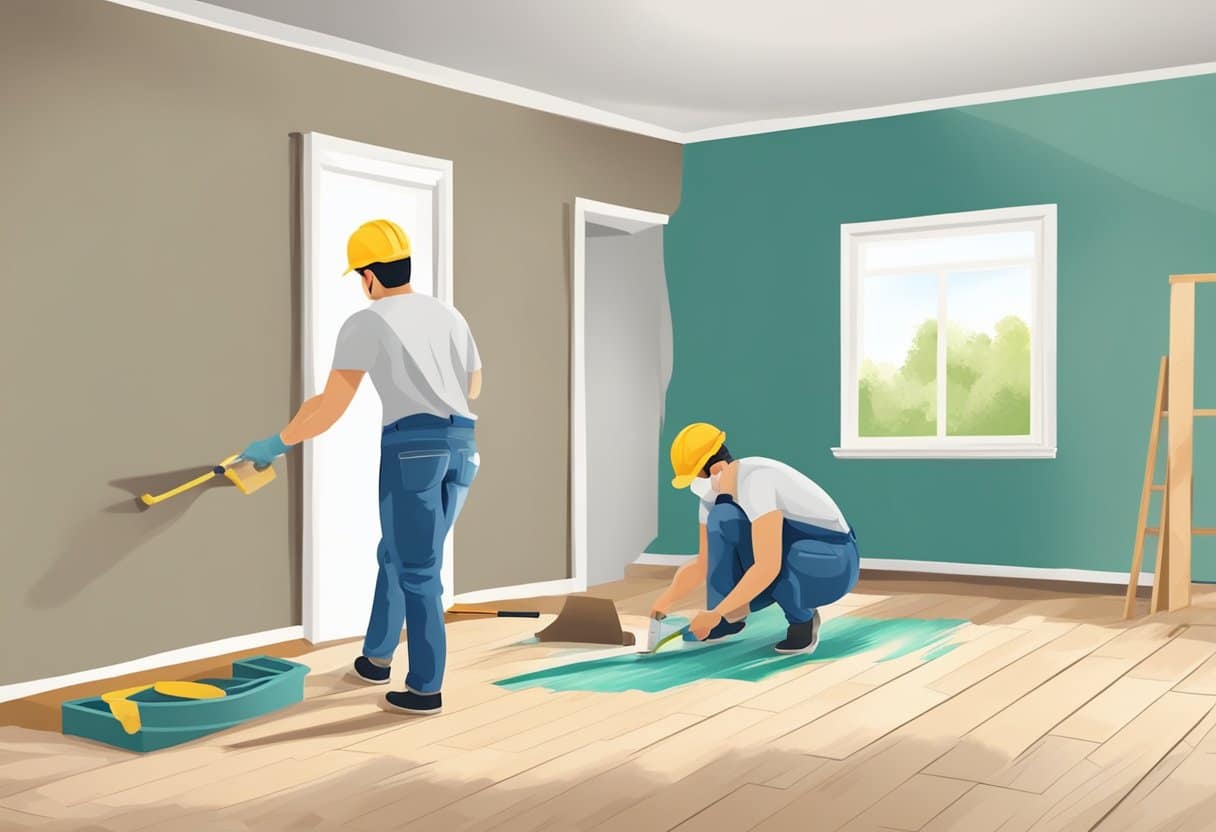
DIY Home Repairs: Save Money and Be Your Own Handyman
DIY Home Repairs are not just a way to save a few bucks; they’re your ticket to the coveted throne of Home Improvement Royalty. Imagine the scene: you, the fearless DIY monarch, scepter (or should I say wrench?) in hand, vanquishing the dragon of costly professional repairs with nothing but your wits and a trusty YouTube tutorial. Ah, the glory! But before you don your crown and cape, let’s get real for a moment. Embarking on the noble quest of fixing up your castle (aka your two-bedroom suburban semi-detached) can be fraught with peril – or at least the peril of a leaky faucet turning into a surprise indoor pool.
Now, I know what you’re thinking. “But I can barely assemble an IKEA shelf without calling my mom for moral support!” Fear not, fellow home improver, because this blog post is your secret weapon. With a sprinkle of patience, a dash of determination, and a healthy dose of humor, you’ll be patching up drywall and silencing squeaky hinges like a pro.
So, roll up your sleeves and let’s dive into the nitty-gritty of DIY Home Repairs. Whether you’re tackling the mysterious innards of your plumbing or bravely facing the labyrinth of your electrical panel, I’ve got the tips, tricks, and cheeky advice to guide you through. And who knows? By the end of it all, you might just find that being your own handyman is more rewarding than you ever imagined – and not just for your wallet. Let’s turn those ‘uh-oh’ moments into ‘aha!’ triumphs, one quirky, cost-saving repair at a time.
Maintaining a home can be a daunting task, but it’s a necessary one. Regular maintenance can help prevent costly repairs down the line. However, hiring professionals to handle every issue can quickly add up. That’s where DIY home repairs and maintenance come in. By doing it ourselves, we can save money and learn valuable skills along the way.

There are a variety of tasks that homeowners can tackle on their own. From fixing leaky faucets to painting a room, DIY projects can range in difficulty and time commitment. By taking the time to learn how to do these tasks ourselves, we can save money on labor costs and feel empowered by our newfound knowledge. Plus, completing a project on our own can be incredibly satisfying.
Being a homeowner means taking responsibility for the upkeep of our homes. While it may seem overwhelming at first, tackling maintenance and repairs ourselves can be a cost-effective and rewarding solution. With the right tools and a willingness to learn, we can become confident DIYers and keep our homes in top shape.
Getting Started with DIY Home Repairs

When it comes to DIY home repairs and maintenance, getting started can be overwhelming. However, with the right tools and materials, anyone can tackle basic repairs and save money in the process. In this section, we will cover two important aspects of getting started with DIY home repairs: essential tools and materials, and understanding your home’s structure.
Essential Tools and Materials
Before starting any DIY home repair project, it is important to have the right tools and materials on hand. Here are some basic tools that every homeowner should have in their toolkit:
- Hammer
- Screwdrivers (both flathead and Phillips head)
- Pliers
- Adjustable wrench
- Tape measure
- Level
- Utility knife
- Safety glasses
- Work gloves
In addition to these tools, it is also important to have the right materials for the job. This may include:
- Screws and nails
- Drywall patching compound
- Paint and paintbrushes
- Caulk and caulk gun
- Electrical tape
- Plumbing tape
- Duct tape
By having these basic tools and materials on hand, you will be prepared to tackle a wide range of DIY home repair projects.
Understanding Your Home’s Structure
Another important aspect of getting started with DIY home repairs is understanding your home’s structure. This includes knowing where important components are located, such as electrical panels, water shut-off valves, and HVAC systems.
It is also important to understand how your home is constructed, including the types of materials used and how they are installed. This knowledge can help you identify potential issues and make informed decisions about repairs.
In conclusion, getting started with DIY home repairs and maintenance requires the right tools and materials, as well as a basic understanding of your home’s structure. By following these tips, you can save money and tackle basic repairs with confidence.
Money-Saving Maintenance Techniques

As homeowners, we know that regular maintenance is essential to keep our homes in good shape and prevent costly repairs. However, did you know that proper maintenance can also help you save money on home repairs and energy bills? In this section, we will discuss some money-saving maintenance techniques that every homeowner should know.
Regular Maintenance Schedules
Regular maintenance schedules are crucial in preventing small problems from turning into big ones. By having a routine maintenance schedule, we can detect and address small issues before they become major problems that require costly repairs. Some regular maintenance tasks that we should consider include:
- HVAC system maintenance: Regularly clean or replace air filters, check ductwork for leaks, and have a professional inspect and tune-up our HVAC system annually.
- Plumbing maintenance: Inspect pipes for leaks, clean drains and gutters, and flush water heaters annually.
- Electrical maintenance: Check electrical panels and outlets for signs of wear and tear, and have a professional inspect our electrical system every few years.
By following a regular maintenance schedule, we can save money on repairs and extend the lifespan of our home’s systems.
Energy Efficiency Upgrades
Another way to save money on home maintenance is by making energy efficiency upgrades. By reducing our home’s energy consumption, we can save money on our utility bills and reduce our carbon footprint. Some energy efficiency upgrades that we should consider include:
- Insulation: Proper insulation can help keep our home warm in the winter and cool in the summer, reducing our energy bills. Consider adding insulation to attics, walls, and basements.
- Weatherstripping: Proper weatherstripping can help seal gaps around doors and windows, preventing drafts and reducing our energy bills.
- Energy-efficient appliances: Upgrading to energy-efficient appliances can help reduce our energy consumption and save money on our utility bills.
By making energy efficiency upgrades, we can save money on our utility bills and reduce our impact on the environment.
In conclusion, regular maintenance and energy efficiency upgrades are essential techniques that every homeowner should consider to save money on home maintenance. By following a regular maintenance schedule and making energy efficiency upgrades, we can prevent costly repairs and reduce our energy bills.
Interior Home Repair Projects

When it comes to interior home repairs, there are a number of projects that you can tackle on your own to save money. Here are a few common issues and tips for fixing them.
Fixing Common Issues
Water Stains
Water stains on your ceiling or walls can be unsightly and may even be a sign of a larger problem. Before you try to cover them up with paint, it’s important to identify the source of the water and fix the problem. Once you’ve done that, you can use a bleach solution to clean the stain and prevent mold growth. Be sure to wear gloves and protective eyewear when working with bleach.
Squeaky Floors
If you have squeaky floors, there are a few different approaches you can take to fix the problem. One option is to use shims to fill gaps between the subfloor and joists. Another option is to use screws to secure the subfloor to the joists. If you’re not sure which approach is best for your situation, consult a professional.
Wobbly Chairs
Wobbly chairs can be a nuisance and even a safety hazard. To fix a wobbly chair, start by tightening any loose screws or bolts. If that doesn’t work, you may need to add shims to stabilize the legs. If the problem persists, it may be time to replace the chair.
Painting and Caulking Tips
Painting
Painting is a great way to freshen up your home’s interior and can be a DIY project if you’re willing to put in the time and effort. Before you start painting, be sure to prep the walls by cleaning them and filling any holes or cracks. Use painter’s tape to protect trim and other areas you don’t want to paint. When choosing paint, opt for a high-quality brand and consider using a primer for better coverage.
Caulking
Caulking is an important part of maintaining your home’s interior. It helps seal gaps and prevent air and water from getting in. When caulking, be sure to choose a high-quality product and follow the manufacturer’s instructions. Use a caulk smoothing tool or your finger to smooth out the caulk and create a clean, even finish.
Exterior Home Care

When it comes to maintaining your home’s exterior, there are a few key areas to focus on to ensure it stays in good shape. In this section, we’ll cover deck and patio maintenance, as well as window and gutter upkeep.
Deck and Patio Maintenance
Your deck and patio are both important features of your home’s exterior, and they require regular maintenance to keep them looking their best. One of the most common issues with decks and patios is fading or discoloration due to exposure to sunlight and weather. To prevent this, it’s important to apply a sealant or stain every few years to protect the wood or concrete.
Another common issue with decks and patios is cracking or splitting. This can be caused by changes in temperature or moisture levels. To prevent this, make sure to keep your deck or patio clean and free of debris, and fill in any cracks or gaps with a sealant.
Window and Gutter Upkeep
Your windows and gutters are also important parts of your home’s exterior, and they require regular upkeep to keep them functioning properly. One of the most common issues with windows is fogging or condensation between the panes of glass. This can be caused by a broken seal, and it’s important to have it repaired as soon as possible to prevent further damage.
Gutters are also important to maintain, as they help to direct water away from your home’s foundation. Over time, gutters can become clogged with leaves, sticks, and other debris, which can cause water to overflow and damage your home’s exterior. To prevent this, it’s important to clean your gutters regularly and make any necessary repairs.
Overall, by taking the time to maintain your home’s exterior, you can save money in the long run by preventing costly repairs and replacements. Whether it’s deck restoration, reglazing your windows, or simply cleaning out your gutters, a little bit of effort can go a long way in keeping your home in top condition.
Flooring and Wall Renovations

Repairing Hardwood and Carpet
When it comes to home repairs and maintenance, fixing damaged flooring is one of the most common tasks. Hardwood floors are beautiful and durable, but they can become scratched or dented over time. Carpet, on the other hand, can become stained or frayed. Fortunately, repairing both hardwood and carpet is often a DIY job that can save you money.
For hardwood floors, start by sanding down the damaged area and then filling in any gaps or holes with wood filler. Once the filler has dried, sand the area again and then apply a new coat of finish. For carpet, start by trimming any frayed edges and then patching the damaged area with a new piece of carpet. Use a carpet seam iron to join the new piece with the existing carpet.
Updating Wall Finishes
Updating your wall finishes can be a great way to give your home a fresh new look. Wood paneling, for example, can be painted over to create a more modern and updated look. Start by cleaning the paneling with a degreaser and then lightly sanding it to create a rough surface for the paint to adhere to. Use a primer before applying the paint to ensure it adheres properly.
If you have drywall, you can update the look by adding texture. This can be done using a drywall texture roller or a spray-on texture. Simply apply the texture to the wall and then use a trowel or putty knife to create the desired pattern. Once the texture has dried, you can paint over it to complete the new look.
Overall, repairing and updating your flooring and walls can be a great way to save money and give your home a fresh new look. With a little knowledge and some elbow grease, these DIY tasks can be easily accomplished.
Kitchen and Bathroom Remodeling

DIY Remodeling Basics
When it comes to remodeling your kitchen or bathroom, there are a few basics that you should keep in mind. First, make a plan and stick to it. This means deciding on a budget, choosing a design, and selecting the materials you’ll need. It’s also important to have all the necessary tools on hand before you begin.
Another important aspect of DIY remodeling is knowing your limits. While it’s great to save money by doing the work yourself, there are some tasks that are best left to professionals. For example, if you’re not comfortable with electrical work or plumbing, it’s best to hire someone who is.
Plumbing and Appliance Fixes
One of the most common issues in both kitchens and bathrooms is plumbing problems. From leaky faucets to clogged drains, these issues can be frustrating and costly to fix. However, with a little know-how, many plumbing problems can be fixed on your own.
One common appliance in the kitchen that can cause problems is the garbage disposal. If you’re experiencing issues with your garbage disposal, the first step is to turn off the power. From there, you can try clearing any clogs or jams with a tool like an Allen wrench.
When it comes to bathroom plumbing, one common issue is a slow or clogged drain. There are a few DIY solutions you can try before calling in a professional. For example, you can use a plunger or a drain snake to clear the clog. If these methods don’t work, you may need to use a chemical drain cleaner or call in a plumber.
By following these DIY remodeling basics and tackling plumbing and appliance fixes on your own, you can save money and improve the functionality of your kitchen and bathroom.
Major Repairs and Replacements

When it comes to major repairs and replacements, it’s important to know when to take matters into our own hands and when to call in the professionals. Here are a few tips to help you make informed decisions and save money in the long run.
Handling Significant Damage
If you’re facing significant damage to your home, such as a leaky roof or a broken window, it’s important to assess the situation carefully before deciding whether to tackle the repair yourself or call in a professional.
For minor damage, such as a small leak or a cracked window pane, we can often save money by handling the repair ourselves. However, if the damage is more significant, it’s best to call in a professional contractor to ensure that the repair is done correctly and safely.
When it comes to major repairs, such as a damaged foundation or a faulty electrical system, it’s always best to leave the job to the professionals. Attempting these repairs ourselves can be dangerous and may end up costing us more money in the long run.
When to Call Professionals
While DIY repairs can save us money, there are certain situations where it’s best to call in the professionals. Here are a few examples:
- Electrical repairs: Unless we’re experienced electricians, it’s best to leave electrical repairs to the professionals. Working with electricity can be dangerous and mistakes can be costly.
- Plumbing repairs: While minor plumbing repairs such as fixing a leaky faucet can be handled ourselves, more complex repairs such as replacing a water heater or fixing a blocked drain should be left to the professionals.
- Roof repairs: Climbing onto a roof can be dangerous, and repairing a damaged roof can be a complex job. It’s best to call in a professional roofer to ensure that the repair is done correctly and safely.
By knowing when to tackle repairs ourselves and when to call in the professionals, we can save money and ensure that our home is safe and well-maintained.
Financial Planning for Home Maintenance

As homeowners, we all know that regular maintenance and repairs are necessary to keep our homes in good condition. However, these costs can quickly add up and become overwhelming if we don’t plan for them properly. In this section, we will discuss some financial planning tips to help us save money on home repairs and maintenance.
Budgeting for Projects
One of the first steps in financial planning for home maintenance is to create a budget for projects. We should start by making a list of all the repairs and maintenance tasks that need to be done in the near future. Then, we can prioritize the list based on urgency and estimate the cost of each project.
Once we have a list of projects and their estimated costs, we can create a budget for each project and allocate funds accordingly. It’s important to be realistic and conservative when estimating costs, as unexpected expenses can arise during the project.
Understanding Homeownership Costs
In addition to budgeting for specific projects, we should also have a general understanding of the costs associated with homeownership. These costs include mortgage payments, property taxes, homeowners insurance, and home maintenance costs.
Mortgage payments are typically the largest expense for homeowners, and it’s important to budget accordingly. Property taxes can also be a significant expense, and it’s important to understand how they are calculated and when they are due.
Homeowners insurance is another important expense, as it provides protection for our homes and belongings. We should review our policy annually to ensure that we have adequate coverage and are not overpaying for insurance.
Finally, we should also budget for ongoing home maintenance costs, such as HVAC servicing, roof repairs, and landscaping. By budgeting for these costs and planning ahead, we can avoid unexpected expenses and save money in the long run.
In conclusion, financial planning is an important aspect of home maintenance and repairs. By creating a budget for projects and understanding the costs associated with homeownership, we can save money and avoid financial stress.
Frequently Asked Questions
What are some simple repairs we can do ourselves to reduce home maintenance costs?
There are several simple repairs that we can do ourselves to reduce home maintenance costs. Some of these repairs include fixing leaky faucets, replacing air filters, unclogging drains, and patching small holes in walls. By taking care of these small repairs ourselves, we can save money on professional services and prevent larger, more expensive problems from developing.
How can we budget effectively for home repairs and maintenance?
To budget effectively for home repairs and maintenance, we should start by creating a list of all the necessary repairs and maintenance tasks. We should prioritize the list based on urgency and cost, and then estimate the cost of each item. Once we have a total cost estimate, we can divide it by 12 to determine our monthly savings goal. By setting aside a small amount each month, we can avoid being caught off guard by unexpected expenses.
What are some cost-effective strategies for general home repair and maintenance?
Some cost-effective strategies for general home repair and maintenance include regular cleaning and upkeep, using quality materials, and keeping up with routine maintenance tasks. By taking care of our homes on a regular basis, we can prevent small problems from becoming larger and more expensive. Additionally, using quality materials can help prevent the need for frequent repairs and replacements.
Can performing DIY home repairs actually lead to significant savings?
Yes, performing DIY home repairs can lead to significant savings. By taking care of small repairs ourselves, we can avoid paying for professional services and prevent larger, more expensive problems from developing. Additionally, by learning basic home repair skills, we can save money on future repairs and maintenance tasks. However, it is important to note that some repairs should only be performed by professionals, and attempting to do them ourselves could lead to more expensive problems.
Final Thoughts on DIY Home Repairs
And there you have it, the grand tour through the hallowed halls of DIY Home Repairs, where every creaky floorboard and temperamental toilet can bow to your newfound prowess. You’ve braved the depths of under-sink cabinets, jousted with jammed windows, and emerged victorious, tools held high and spirits soaring. But as we draw the curtain on this handyman’s tale, remember that the path of the DIY warrior is one of eternal learning – every stripped screw, every wonky nail is a stepping stone to greatness.
As you step back to admire your handiwork, don’t be surprised if a sense of pride wells up inside you. After all, you’ve not only saved a pretty penny, but you’ve also crafted a home that’s got your fingerprints (quite literally, perhaps) all over it. And should the day come when the drawbridge needs lowering (that’s DIY speak for ‘fixing the garage door’), you’ll be ready, toolkit at the ready, to face the challenge head-on.
So, keep those safety goggles close and your instruction manuals closer, for the realm of DIY Home Repairs is ever-expanding. Share your tales of triumph (and the occasional misadventure) with us in the comments below, and join a community of fellow DIY enthusiasts who know that the true joy of home improvement is in the doing (and occasionally redoing).
Until next time, wear those paint splatters like badges of honor and remember: in the kingdom of DIY, every repair, no matter how small, is a part of your home’s unique story. Now, go forth and caulk like no one’s watching!







































